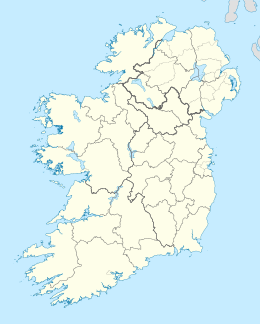Dalkey Island
| Native name: Deilginis | |
|---|---|

Dalkey Island viewed from Killiney Hill
|
|
| Geography | |
| Location | Irish Sea |
| Coordinates | 53°16′19″N 6°05′03″W / 53.272027°N 6.084132°WCoordinates: 53°16′19″N 6°05′03″W / 53.272027°N 6.084132°W |
| Area | 0.09 km2 (0.035 sq mi) |
| Administration | |
| Province | Leinster |
| County | Dublin |
| Demographics | |
| Population | 0 (2011) |
Dalkey Island (Irish: Deilginis meaning "thorny island") is an uninhabited island about 16 km (10 mi) south of Dublin, near the village of Dalkey, 3 km (2 mi) south of Dún Laoghaire harbour. Its name is a meld of the Irish deilg ("thorn") and the Old Norse ey ("island"). The Island had a population of 8 in 1841.
Although the island is currently uninhabited, the remains of houses, a church, a gun battery and the Martello Tower still exist. There are two Holy Wells, one on the Western shoreline is known locally as the "Scurvy Well" and is located within a surrounding stone structure. There is also a bullaun stone formed from an earthbound boulder and this lies close to the church. At the Northern extreminity of the Island there is evidence of a deep ditch ot fosse that was the boundary of a medieval Promontary Fort. Located less than 300 metres off the mainland, the island comprises 9 hectares (22 acres). From Bulloch Harbour, it is possible to visit the island. Also a regular ferry operates from Coliemore Harbour during the summer months.
Dalkey Island, only 5 minutes by boat from Coliemore Harbour, is an important site of ancient and historic remains. Artefacts from the island, now housed in the National Museum in Dublin, provide evidence that the island's original occupants were from the Mesolithic, or Middle Stone Age. Humans continued to use the site through the Neolithic, Iron Age and Early Christian period.
There is evidence it was inhabited in the 4th millennium BC (6,000 years ago) and was also used as a Viking base. A number of early Medieval pieces of pottery and glassware were found on the island. Some of these artifacts came from Mediterranean area, possible Turkey or Greece. There are ruins of another church, dating from the 7th century, named after St Begnet. This was altered on the east side when builders used it as living quarters while building the nearby Martello tower and gun battery in 1804. An older wooden church was probably here before the present stone one was built.
...
Wikipedia

